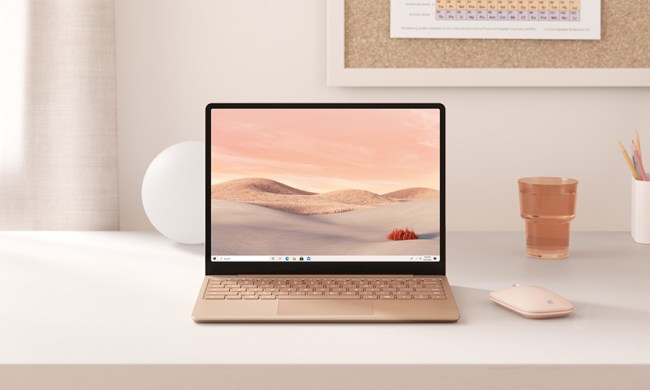
Knowing how much to spend on a device that can function as both a tablet and a laptop isn’t easy. There are ultra-affordable options that do the job just fine and fancier options two, or even three times the cost that make you wonder whether it’s worth spending extra for whatever it is they offer.
To find out which is the best option for most, we pitted the Yoga Book C930 against the Surface Go in a battle that compares not just how they look, feel, and perform, but whether their price tags accurately reflect worth.
Further Reading
Design

Both of these convertible laptop/tablets look fantastic, but in their own, distinct way. The Surface Go is a clear evolution of its predecessors, with Microsoft building on its pedigree with a more shapely, but thin, and portable device. It has a professional and clear silver/grey aesthetic, and the Alcantara coating on the ($130 add-on) type cover is as lovely on the wrists and fingers as ever.
The Yoga Book C930, however, looks like a revolution. The Surface Go feels like a product of today, while the Yoga Book feels exceedingly futuristic. It has a gorgeous aesthetic of its own, including a beautiful watch-like hinge, and a funky “knock-knock” method for opening its cover.
When you do open it, you get a look at the laptop’s dual-screen design which includes a standard QHD, IPS display in the lid and a far-from-conventional E-Ink display at its base. That does mean it lacks a physical keyboard, so you’ll be typing on a touchscreen with some basic haptic feedback. That does take some getting used to and ultimately most people in the Digital Trends offices who tried it thought it was cool, but not something they’d be willing to trade a physical keyboard for. Even if it can double as an e-reader or drawing tablet.
The Surface Go’s keyboard is nice too, with arguably a more satisfying feel to it even if its layout did take some getting used to.
Port selection is somewhat limited on these devices, with just a pair of USB-C 3.1 (Gen 1) ports and a microSD card reader. The Surface Go does at least have a 3.5mm headphone jack, but it has only a single USB-C connector, microSDXC card reader, and Surface Connect port.
Performance

With Lenovo is still yet to officially launch the Yoga Book in the states, we don’t have exact pricing information for its various incarnations. We can say though, that the model we reviewed started $1,000 and featured a Core i5-7Y54 CPU, 4GB of RAM, and 128GB of SSD storage. Far from a powerhouse, but adequate for day-to-day use.
We’re disappointed not to see eighth-generation CPUs from Intel used as part of its configuration, especially the new Y-Series range. That does mean the C930 could start to feel outdated in a couple of years. Its display may not though. As well as having a unique configuration, they are also quite beautiful. Its top IPS panel has a resolution of 2,560 x 1,600 for a crisp image and even the E-ink display is 1080p — although it isn’t backlit.
The Surface Go does have a Y-series chip, but it’s not one of the newest ones. Instead, it packs a Pentium Gold 4415Y which has the same HD 615 graphics core as the Core m3 CPU in the base model Yoga Book, but it’s substantially slower elsewhere and wouldn’t hold a candle to the Core i5 model. But then again, its starting price is just $400, so you can’t expect the same kind of hardware. Its memory and storage are more comparable though, with 4GB and 64GB of SSD space respectively. Every configuration has an 1,800 x 1,200 resolution PixelSense display which delivers crisp, and precise imagery with great brightness and solid color support.
For $550, you can upgrade to 8GB of RAM and 128GB of storage. Though our review unit sported the heftier configuration, the Surface Go wasn’t a particularly great performer. It could handle single, basic tasks well enough, but a dozen browser tabs would bring it to its knees and gaming beyond the absolute barebones indies isn’t an enjoyable experience.
When we compared these two devices in our C930 review, the Lenovo notebook came in significantly faster than the Surface Go in memory and CPU performance tests. It falls behind other devices like the Dell XPS 13, but performance is strong enough with the Lenovo device that we don’t have any major concerns. Still, it’s hard to ignore the pricing disparity. You get less with the Surface Go, but for what it’s designed to do (and at that price point), it offers more value for your money.
Portability

In the 10-inch form factor you have some of the most portable devices in the world and these two devices exemplify that ideal. The Yoga Book C930 measures just 10.25 x 7.1 0.39-inches and weighs 1.71 pounds. The Surface Go though, isn’t far off iPad-like portability, measuring just 9.65 x 6.90 x 0.33-inches, and weighing as little as 1.15 pounds.
Despite the weight disparity, we’re arguably more impressed with the Yoga Book’s weighting since it does pack a pair of displays in almost the same physical space. Its battery is quite comparable too. Lenovo claims eight-hours of battery life in general usage. Our intensive Basemark benchmark ran for just over three hours before the battery died. That’s slightly better than the Surface Go. Microsoft claims up to nine-hours of media viewing in its specifications which proved quite accurate in our testing, but it came in just under three hours in the Basemark test. The Yoga Book C930 has better overall battery life, though we would have liked to have seen more life in a charge from both devices.
Neither have the equation solved, but Surface does it best

Comparing two devices with a big gap in their price tags is no easy task, as typically the more expensive device is better. The question is, is it worth the added expense? In this case, it’s close, but we’d say no. The Yoga Book C930 is more expensive in its base configuration than even the top specced Surface Go with the optional Type Cover accessory. It does offer more, but not enough. For simple day-to-day portable computing, the Surface Go is a better buy.
The Surface Go is the smaller and more portable of the two devices too, and though the Lenovo Yoga Book C930 does have some great features, the lack of a reliable keyboard holds it back. There’s also much more competition at its inflated price point and though we like the dual-screen solution, it’s hard to recommend it over more capable devices at similar costs.
For low-power computing on the go, the Surface Go isn’t the best device, lacking strong performance or battery life, but we’d still recommend it over the Yoga Book for most people.
Overall winner: Microsoft Surface Go



